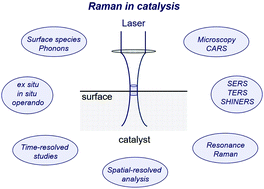New advances in using Raman spectroscopy for the characterization of catalysts and catalytic reactions
Abstract
Gaining insight into the mode of operation of heterogeneous catalysts is of great scientific and economic interest. Raman spectroscopy has proven its potential as a powerful vibrational spectroscopic technique for a fundamental and molecular-level characterization of catalysts and catalytic reactions. Raman spectra provide important insight into reaction mechanisms by revealing specific information on the catalysts’ (defect) structure in the bulk and at the surface, as well as the presence of adsorbates and reaction intermediates. Modern Raman instrumentation based on single-stage spectrometers allows high throughput and versatility in design of in situ/operando cells to study working catalysts. This review highlights major advances in the use of Raman spectroscopy for the characterization of heterogeneous catalysts made during the past decade, including the development of new methods and potential directions of research for applying Raman spectroscopy to working catalysts. The main focus will be on gas–solid catalytic reactions, but (photo)catalytic reactions in the liquid phase will be touched on if it appears appropriate. The discussion begins with the main instrumentation now available for applying vibrational Raman spectroscopy to catalysis research, including in situ/operando cells for studying gas–solid catalytic processes. The focus then moves to the different types of information available from Raman spectra in the bulk and on the surface of solid catalysts, including adsorbates and surface depositions, as well as the use of theoretical calculations to facilitate band assignments and to describe (resonance) Raman effects. This is followed by a presentation of major developments in enhancing the Raman signal of heterogeneous catalysts by use of UV resonance Raman spectroscopy, surface-enhanced Raman spectroscopy (SERS), and shell-isolated nanoparticle surface-enhanced Raman spectroscopy (SHINERS). The application of time-resolved Raman studies to structural and kinetic characterization is then discussed. Finally, recent developments in spatially resolved Raman analysis of catalysts and catalytic processes are presented, including the use of coherent anti-Stokes Raman spectroscopy (CARS) and tip-enhanced Raman spectroscopy (TERS). The review concludes with an outlook on potential future developments and applications of Raman spectroscopy in heterogeneous catalysis.



 Please wait while we load your content...
Please wait while we load your content...